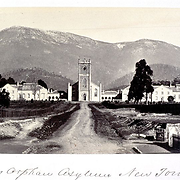
Queens Orphan Asylum New Town, 1863, courtesy of Tasmanian Images: Tasmanian Archive and Heritage Office.
Details
Colony of Tasmania
The Charitable Grants Department, also known as the office of the Administrator of Charitable Relief, was established in 1873. It provided outdoor relief, that is, funds or food given to poor people not living in an institution. The Department also administered legislation relating to the care of destitute children, including the boarding out system introduced by the Act, and the inspection and supervision of charitable institutions. In 1901, following Australian federation, Tasmania became a state and the state government took over the management of the Charitable Grants Department.
The precursor to the Charitable Grants Department began in 1862 as a system of outdoor relief. The Hobart Town Police Magistrate, William Tarleton, administered the system, with the help of the Office of the Inspector of Police. Most of the assistance went to elderly people in poverty and destitute children waiting for admission to institutions. The system led to one of the early boarding out schemes in Tasmania. Instead of sending all the children to institutions, Tarleton began paying a small fee to women living in the country to take care of the them. In 1871, he told the Royal Commission into Charitable Institutions that 45 children were already boarded out.
The Royal Commission recommended the creation of a Charitable Relief Commission to take over outdoor relief and to manage the various government-run institutions. This did not happen. Instead, in 1873, following the passage of the Public Charities Act, the government established the Charitable Grants Department. Its role was to manage outdoor relief and the modest boarding out scheme that the Act had set up. Tarleton was the first Administrator of the Department.
Management of outdoor relief in Hobart fluctuated between the Department and the Benevolent Society. In 1880, the government gave the Society responsibility for outdoor relief. This seems to have been an attempt to save money. The Society believed strongly that receiving charity weakened individuals' resolve to help themselves. They only gave it according to strict criteria. This resulted in a cost saving because there were fewer recipients. The Hobart Benevolent Society also took over the boarding out system temporarily in 1880. Management of that soon returned to the Department which, until 1896, ran it through volunteer boarding out committees.
The roles of the Charitable Grants Department and the Hobart Benevolent Society were not clearly defined. In particular, the Society wanted the right to admit people to institutions, which the Department refused. This led to some bad feeling. The Charitable Institutions Act, which was designed to protect the funds of charities, passed in 1888. The Benevolent Society refused to register under it. When the government insisted, the dispute became heated and the Department resumed control of outdoor relief in 1889.
The government employed an Inquiring Officer, whose role it was to report on children's circumstances prior to commital and to inspect foster homes. The Inquiring Officer, invariably a man, was employed by the government prior to the formation of the Neglected Children's Department and for a while afterwards. (In 1911, inspecting nurses, professionally trained women, took over the role of Inquiring Officer.)
In 1896, following the passage of the Youthful Offenders, Destitute and Neglected Children's Act, a Neglected Children's Department was formed. The Charitable Grants Department relinquished the boarding out system. Even so, the two Departments were closely related, with the Secretary of the Neglected Children's Department also being the Administrator of Charitable Grants. In addition, he managed the Boys' Training School, the Invalid Depot in Launceston and the New Town Charitable Institution. The offices for all these activities were at the New Town Charitable Institution, on the site of the former Queen's Orphan Asylum. The first Administrator of the Charitable Grants Department was George Richardson. When he became Commissioner of the newly created Police Department in 1898, FR Seager replaced him. Seager lived on the grounds of the Institution with his wife and eight children.
In 1901, after the newly formed state government took control of the Charitable Grants Department, its close relationship with the Neglected Children's Department continued.
1873 - 1901 Charitable Grants Department
1896 - 1901 Neglected Children's Department
1901 - 1934 Charitable Grants Department
1901 - 1918 Neglected Children's Department
1934 - 1961 Social Services Department
1918 - 1935 Children of the State Department
1961 - 1983 Social Welfare Department
1934 - 1961 Social Services Department
1983 - 1989 Department for Community Welfare
1989 - 1993 Department of Community Services
1993 - 1998 Department of Community and Health Services
1998 - Department of Health and Human Services
2018 - 2022 Department of Communities Tasmania
2022 - Department for Education, Children and Young People, Tasmanian Government
Sources used to compile this entry: Brown, Joan C., 'Poverty is not a crime': the development of social services in Tasmania, 1803-1900, Tasmanian Historical Research Association, Hobart, 1972, 192 pp; Daniels, Dennis, 'Social welfare', in The companion to Tasmanian history, Centre for Tasmanian Historical Studies, http://www.utas.edu.au/library/companion_to_tasmanian_history/S/Social%20welfare.htm; Evans, Caroline, Protecting the Innocent: Tasmania's Neglected Children, Their Parents and State Care, 1890-1918, University of Tasmania, Hobart, 1999, 251 pp, http://eprints.utas.edu.au/14453/; Ombudsman Tasmania, Listen to the children: Review of claims of abuse from adults in state care as children, Office of the Ombudsman, Tasmania, Hobart, November 2004. Also available at https://nla.gov.au/nla.obj-1382077009/view. pp.58-59..
Prepared by: Caroline Evans
Created: 12 January 2011, Last modified: 13 February 2019